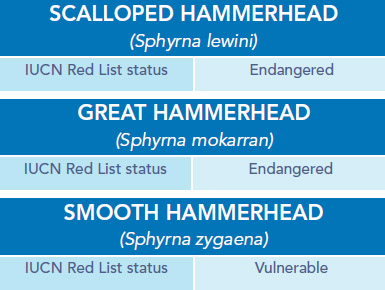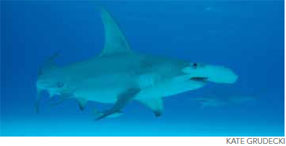Hammerhead Sharks
Reasons to support a prohibition on retention by IATTC fisheries
 Hammerhead sharks are targeted for their highly valued fins and are also caught as bycatch.
Hammerhead sharks are targeted for their highly valued fins and are also caught as bycatch.- They have some of the lowest recovery potentials in comparison to other shark species, which makes them extremely susceptible to extinction.
- Hammerhead sharks, caught both in the longline and purse seine fisheries, are among the top shark species caught in the eastern Pacific Ocean.
- Their distinct body shape makes them easy to identify as a genus, but fishermen have trouble telling the hammerhead species apart.
- With the majority of hammerhead catch being labeled as "hammerhead" instead of individual species, managers are unable to accurately assess the status of specific hammerhead species.
- Catch data are limited, but populations are shown to be declining.
- Hammerheads are one of the few shark speices that school, making them easier to target.
- Reports have also shown juvenile and neonate hammerheads are being targeted in coastal fisheries, particularly in gillnets.
Biological vulnerability to overexploitation
- Low reproductive capacity, with average litters of 14 to 26 pups.
- Slow intrisic population growth in comparison with other species of sharks.
- Long gestation period of eight to 12 months.
- Long reproductive periodicity, reproducing only every two years.
Scalloped hammerhead fisheries and trade
 The scalloped hammerhead shark, one of the most distinctive creatures on the planet, is subject to targeted fisheries, illegal fishing, and fishery bycatch throughout the world. Unlike other species of sharks, hammerheads frequently aggregate in large numbers, which makes them more vulnerable to fishing efforts. Furthermore, hammerheads are among the most frequently taken shark species in illegal, unreported, and unregulated fishing. In the eastern Pacific Ocean, hammerheads are both targeted and caught as bycatch in the purse seine and longline fisheries. The purse seine fishery reported the catch of 100 tons of hammerheads in 2011.
The scalloped hammerhead shark, one of the most distinctive creatures on the planet, is subject to targeted fisheries, illegal fishing, and fishery bycatch throughout the world. Unlike other species of sharks, hammerheads frequently aggregate in large numbers, which makes them more vulnerable to fishing efforts. Furthermore, hammerheads are among the most frequently taken shark species in illegal, unreported, and unregulated fishing. In the eastern Pacific Ocean, hammerheads are both targeted and caught as bycatch in the purse seine and longline fisheries. The purse seine fishery reported the catch of 100 tons of hammerheads in 2011.
Species-specific data are limited, but market-based scientific inquiries have yielded important trade information. Traders have stated that hammerhead fins are some of the most valuable in the market. The three hammerhead species (Sphyrna lewini, S. mokarran, S. zygaena) combined make up approximately six percent of the identified fins entering the Hong Kong market. From this information, scientists have estimated that 1.3 million to 2.7 million scalloped and smooth hammerheads are exploited for the fin trade every year.
Conclusion
The scalloped hammerhead, with the look-alike species great and smooth hammerheads, were proposed for inclusion on CITES Appendix II in 2010, which would have regulated international trade of these species, but the proposal feel short, with many countries arguing that sharks should be regulated through RFMOs instead of CITES. As a result, the Commission should protect these vulnerable species by prohibiting the retention of hammerheads in all fisheries in the Convention area and requesting the immediate live release of any hammerhead shark.











